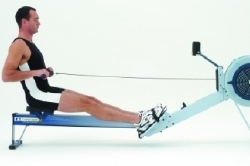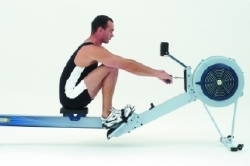
Indoor rowing
Terry O’Neill, fitness consultant at Concept2 provides his top tips on rowing and an exercise guide on how to adopt the correct technique to gain the best results from a rowing programme.
This is why Indoor Rowing is our Exercise of the Week:
20 minute bursts on the indoor rower each day is better than three 40 minute stints at the gym.
20 minutes on a indoor rower provides a full body workout. You don’t have to be up at the crack of dawn to start training and you can participate in this fun activity indoors in your own time. It tones every part of your body - legs, arms, bums and tums.
Banish Bingo Wings. If you are even slightly overweight some fat will be resident in the underarm area. Rowing burns calories fast and effectively which will reduce the fat and help achieve the lean and toned look. With rowing, the harder you pull the more resistance you develop which in turn works the arm muscles more intensely. People find it easy to build in short bursts of intensity into their rowing programmes and this raises the body’s metabolic rate, which in turn ‘burns fat’. Research has shown that the rhythmical action of rowing and the fact that it is low-impact make rowing fun even when you’re working hard and this makes you more likely to stick to it as regular exercise which is vital to keep bingo wings at bay.

1) Introduction
- Always warm up, cool down and stretch thoroughly before and after each training session
- Take time to develop the correct technique before increasing training intensity
- When beginning an exercise programme don’t overdo it; start slowly and build up gradually.
- Drink plenty of water during and after exercise. Don’t wait until you are thirsty.
- Keep a training log to help set realistic goals and targets and plan future programmes of work.
2) Include stretching in your warm up
Stretching is an essential part of any workout. It promotes the elasticity of the muscles, ensuring they are capable of performing the training tasks you set them. However, before doing any stretching it is important to warm the muscles up.
 3) Technique
3) Technique
The correct technique is essential for gaining the best results from your rowing programme. The effort that you put into refining your technique during the early stages will improve both your performance and enjoyment of the exercise. Illustrated below are the two phases of the rowing stroke – The Recovery and The Drive that blend together into one fluid movement.
The Finish
Lean back slightly, legs flat, handle drawn to the body.
Forearms horizontal.
Arms extend, body rocks forward
The arms are relaxed and extended fully.
The body rocks forward from the hips.
The Slide
After the arms have fully extended and the body rocked forward, slide forward maintaining arm and body position
The Drive - Full Slide - The beginning
Shins vertical with body pressed up to the legs.
The arms are straight and relaxed.
The position should not feel uncomfortable.
The start of The Drive
The legs push down and the body begins to lever back.
The Drive continued
The legs continue to push as the body levers back.
The arms remain straight.
The body stops levering back
The arms draw the handle past the knees and then strongly to the body, returning to the Finish position.
Legs flat.
Forearms horizontal.
The Finish
Lean back slightly, legs flat, handle drawn to the body.
Forearms horizontal.
You are now ready to take the next stroke.
Femalefirst Taryn Davies
Tagged in Health exercise fitness tips

